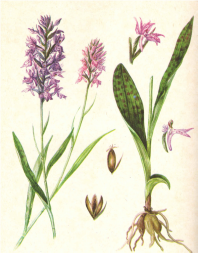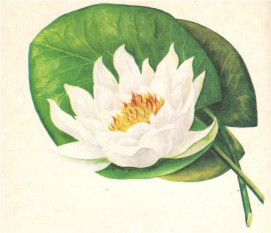The species differ from Orchis by having only two broad-oval basal leaves; stem leaves are either absent or very small. The flower structure is similar, but the lip is entire, and the tuberous roots are oval. Two species are used.
Lyubka bifolia — Platanthera bifolia (L.) L. Rich. — has white, very fragrant flowers, hence its common name, «night violet.» It grows throughout the forest zone.
Lyubka chlorantha — Platanthera chloranta Cust. — has greenish, non-fragrant flowers and grows only in the Caucasus.
Kokushnik komarnikovy — Gymnadenia conopsea R. Br.
Leaves are linear-lanceolate; flowers are lilac-red; the lip is small, ovate, and the tuberous roots are palmate. It grows throughout the forest zone.
Anacamptis pyramidalis — Anacamptis pyramidalis Rich.
Leaves are linear, tuberous roots are ovate, and flowers are purple. It is distinguished by its large ovate-pyramidal inflorescence. It grows in Crimea and the Caucasus. The tuberous roots are collected during flowering and shortly after (June–July) while the flowering stalk is still visible, as the plant becomes hard to locate in dense grass later. Only young daughter tubers are taken, and old ones are discarded. The tubers do not dry in the air but instead sprout. To destroy enzymes, collected tubers are strung on a thread and dipped for a few minutes in boiling water, after which they are dried. Dried tubers are very hard, light in color, and odorless. The finished raw material is called «Tuber Salep» — Tuber Salep.
The tubers contain about 50% mucilage, composed of mannan, and about 27% starch.

The mucilage in salep tubers provides coating properties. Salep tubers, in the form of mucilage, are used in pediatric practice as a coating agent for gastrointestinal diseases (gastritis, enterocolitis), prescribed orally or in the form of enemas, as well as for poisoning by certain toxins.
Salep mucilage — Mucilago Salep — is prepared as follows: 2 g of coarse tuber powder is scalded with 200 ml of boiling water and shaken for 10–15 minutes. It is taken 1 teaspoon or dessert spoon 2–3 times a day.
The coating effect is due to the high mucilage content in the tuberous roots. The mucilage protects sensitive nerve endings in the stomach and intestines from irritation and prevents the absorption of toxins from the intestines.








